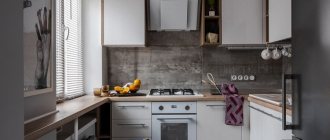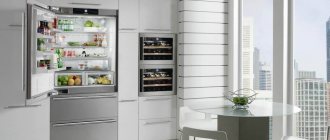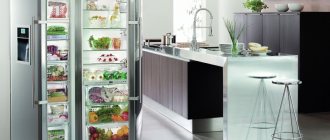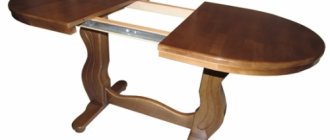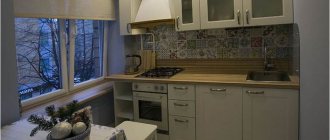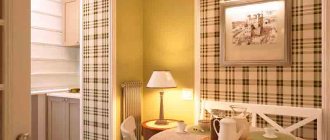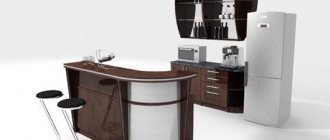When the kitchen has very modest dimensions, placing household appliances in it becomes a real problem. This is especially true for large equipment, which is why many owners abandon standard devices in favor of compact modifications. One of these is a refrigerator built under the kitchen countertop.
Such equipment has modest dimensions. The built-in refrigerator is compact, low, but in terms of functionality it is in no way inferior to its larger brother. In addition to significant space savings, it has a number of other important advantages:
- makes less noise than a standard refrigerator;
- consumes less electricity due to improved thermal insulation;
- the more spacious the free-standing refrigerator with the same dimensions;
- fits perfectly into any design, as it is almost invisible in the interior. For the same reason, it can be installed not only in the kitchen, but also in the office, hotel room, etc.;
- convenient to use.
The only downside is that such equipment is not very suitable for large families, since it may not fit the required amount of food. Otherwise, a compact refrigerator is an excellent option for any kitchen.
Varieties
Refrigeration equipment built under the countertop can have different purposes. There are several categories of such technology:
- refrigerator directly. Usually it is single-chamber; this technique is intended exclusively for cooling products. The equipment may have one or two doors, mechanical or electronic control;
- freezer. Designed for quick freezing and long-term storage of food. Such equipment is necessary if you regularly make various blanks and semi-finished products;
- wine cabinet. Its purpose is clear from the name. This bar equipment has some distinctive features aimed at storing alcohol as correctly as possible. The bottles are placed on the shelves at an angle, which protects the corks from drying out. The cabinet has a built-in carbon filter, thanks to which there will definitely be no unpleasant odors inside the equipment. Spaciousness also matters: the ergonomics of the internal space of the equipment is such that up to 253 bottles can fit there (depending on the specific model of the bar cabinet). Another advantage is vibration resistance.
How to choose a built-in wine cabinet - briefly
How to hide a refrigerator in the kitchen: the most convenient options
In small rooms, large appliances clutter the interior. To ensure that the refrigerator does not fall out of the design concept, the equipment must be properly hidden. The hidden storage area fits naturally into the design of the space.
Small refrigerator under the window
A miniature model without a freezer in the kitchen can be installed in a niche from the radiator. The battery is moved to the side or the heating is installed in the baseboard. A small unit is placed in the freed space, which is several centimeters below the level of the window sill. When opening, the door should not come into contact with nearby furniture.
Small built-in refrigerator under the work area Source ciscoexpo.ru
Great idea: a refrigerator under the work area
A small-sized model with a height of up to 80 cm is placed under the tabletop of a workspace, bar counter or dining set. A miniature refrigerator does not require much space in the kitchen interior. The unit fits harmoniously into the composition with the rest of the furniture. The door is covered with a film that repeats the pattern on the objects.
Low built-in refrigerator Source chudo.tech
Refrigerator in the corner of the kitchen
One of the most successful options for placing a food storage area. The device in the far part does not clutter up the room and does not disturb the inhabitants of the home. The unit built into the set is almost invisible and visually makes the low ceiling higher. It is better to place large interior items against the wall.
Refrigerator in the interior Source yandex.ru
The refrigerator in the corner of the kitchen on one side gradually merges into the work area. The place is as comfortable as possible away from the sink, and household members do not constantly stumble upon the food storage area. For a large family, preference is given to a tall model with a narrow body, which is hidden under a box or furniture door.
Wooden set Source znatprovse.ru
With a corner layout, the refrigerator is placed near the window. The effect of rounding sharp surfaces is created. The window sill can be converted into a work area or the sink can be moved. A beautiful and functional solution saves usable space in the room. In the process of cooking, a person spends less energy when moving from one area to another.
Kitchen up to the ceiling in neoclassical style Source ileds.ru
The refrigerator in the kitchen interior can be placed in the corner near the entrance. A spacious niche or flat wall is perfect for installing the unit. The equipment does not fall out of the overall design composition; it becomes a continuation of the headset. The facades often repeat the pattern of the doors of the bedside tables.
Small space Source www.eckti.com
Large refrigerator in the kitchen Source www.ipeople.in.ua
To make the refrigerator take up less space in space, you need to move the device as close as possible to the wall. If the kitchen is combined with a loggia, then the unit is appropriate in the far part of the insulated balcony. There should be no boundaries of furniture, partitions or doors between the storage, washing and cutting areas.
Refrigerator by the windowsill Source maximusokna.ru
Criterias of choice
The first thing you should pay attention to when choosing a built-in refrigerator is its dimensions. The mini-equipment must fit successfully into the space allocated for it, so first take measurements of the desktop in which you are going to install it.
We wrote in detail about the sizes of built-in refrigerators and cabinets here >>>
In general, the following size options are available:
- width 600 mm;
- depth 600 mm;
- height from 820 to 870 mm;
- volume from 140 to 180 liters.
Of course, you can find equipment with other dimensions. For example, there are very narrow refrigerators. But this option is usually small in volume, so it is suitable for 1-2 people, no more.
The second selection criterion is the number of cameras. Single-chamber technology has narrower functionality. And a two-chamber one - that is, a refrigerator connected to a freezer - is capable of solving more problems.
The next important parameter is the presence of additional functionality. For example, if we talk about a regular refrigerator (with or without a freezer), then you need to pay attention to the type of cooling system.
It can be drip . In this case, the condensation formed during operation of the refrigerator collects on the inner rear wall and freezes there. Periodically, such equipment has to be defrosted, which is associated with great inconvenience and time consumption.
The no frost system is more popular . In such a refrigerator there is no condensation at all, and therefore there is no need for defrosting. The only disadvantage is the higher cost compared to the drip system. But considering the time savings, this still turns out to be a profitable solution.
An interesting feature found in many modern models is Bio Fresh . This system makes it possible to regulate the microclimate inside the entire refrigeration chamber or any of its departments. This function is needed to keep food fresh three times longer. This is especially important for vegetables, fruits and herbs.
Also pay attention to the interior arrangement of the refrigerator and freezer. Instead of regular shelves, there may be drawers. This is very convenient because you don't have to bend over too much to look deep into the refrigerator. The boxes are great for storing drinks, fruits and other products.
As for wine cabinets, it is important to consider the possibility of adjusting the temperature. It is necessary if you usually store several different types of alcohol.
The wine cabinet can be mono-temperature, then adjustment is impossible. But the multi-temperature one is more interesting, although it has a higher cost.
And the last thing you need to pay attention to is the doors.
If the refrigerator is not hidden behind the facade of the kitchen unit, then its door should open in the same direction as that of the work tables.
If you plan to cover the equipment with a facade, then it is very important that the design of the existing door does not interfere with this.
What are the advantages
A refrigerator, the location of which is a niche under the countertop, has several important advantages over a stationary one. You can make a comparison yourself, and only then decide which one to put in the kitchen: a regular stationary one, or one that is built into a cabinet under the countertop.
Advantages:
- It is possible to organize an individual design in the kitchen - such a composition looks like something from a picture in an interior magazine, where all the elements can be assembled in a holistic image;
- In this way, precious space is saved in a small kitchen, where there simply won’t be any unnecessary furniture;
- Compared to the larger one, less noisy;
- Electricity is definitely saved, since materials that increase thermal insulation are used for its manufacture, i.e. energy costs are reduced;
- Such models, oddly enough, are distinguished by increased capacity - everything can be placed compactly there, observing the basic rules;
- They are widely used not only for kitchens, but also, for example, for offices, bars and hotels, so you can even play up an elegant design.
You can install such a device in a corridor or hallway (for example, in a closet). This can be either a single-chamber or a two-door version. In any room, even in the living room or closet, even on the balcony, placement at your discretion, there can be such a refrigerator.
Installation Rules
The installation process itself does not raise any questions - just place the equipment and connect it to the network. But before that, it is important to choose the right place. There are several requirements that must be met:
- The refrigerator should not be located close to other equipment - especially heating equipment. It should be placed at least across the table from the oven or microwave. Accordingly, it cannot be placed under the hob either; it can only be mounted under the worktop;
- There should be an empty space of about 7 cm between the walls of the refrigerator and the niche in which it is built. This will allow for normal air circulation;
- Also, for ventilation, it is necessary that the surface under the refrigerator is not solid. It should be placed on a grated bottom;
- It is also necessary to leave a gap between the back wall and the wall.
Also, when choosing a place, consider your own comfort. The stove, sink and refrigeration equipment should form a working triangle, the distance between them should be from 1.2 m to 2.7 m. This approach will allow you not to waste a lot of energy running around the kitchen and will make cooking as convenient as possible.
The most inconvenient options for placing a refrigerator
The appliance is one of the vertices of the working triangle, so comfort in the kitchen depends on the correct location. The unit should fit naturally into the interior without interfering with rest and cooking. There are common mistakes that occur when placing a refrigerator.
In line with the sink
According to the laws of ergonomics, an interval of 60 cm is maintained between the functional zones of the working triangle. Drops of water while washing dishes or food can fall on the wires of an electrical appliance, which will cause a short circuit. To avoid problems, an area for unloading food is placed between the sink and the refrigerator. A small table will protect you from dangerous moisture and help you organize the space correctly.
Between the furniture
No obstacles should be placed between the areas of the work triangle. A table, bar counter or soft corner interferes with comfortable movement around the kitchen. In a small room, miniature food storage appliances built into a countertop or cabinet are appropriate.
Kitchen with large refrigerator Source www.yzdxgs.com
Next to the stove
The refrigerator in the kitchen interior cannot be placed near the stove (gas, electric). The adjacent walls heat up, which forces the compressor to constantly work. If parts operate at maximum capacity, they wear out quickly. During cooking, drops of fat stain plastic panels.
Refrigerator in the same row with the stove Source remont-samomy.ru
The unit must not be placed next to a stove or hob. Large pots or pans with handles cannot fit on the nearby burners. An interval of 30-50 cm must be maintained between devices. A bedside table with drawers is placed in the empty area, and a work area is equipped on top.
Fridge in gray Source www.quintain.co.uk
The refrigerator is often built into a box. The surfaces of the structure absorb heat and protect the body from contamination. Additionally, the walls of the device are covered with thermal insulation film. Between the stove (oven) and the unit, you can install a built-in partition screen made of plasterboard, plywood or MDF.
Near heating devices
Radiators and pipes near the refrigerator operate constantly during the heating season, so it is not recommended to place them nearby. In a small kitchen, a distance of 5-10 cm is maintained between appliances. If the interval is not possible, then the battery is hidden under a decorative screen made of:
- rattan;
- wood;
- drywall.
A refrigerator built into a box in a kitchen interior will receive less heat than a free-standing one. The heating pipe is hidden with a curtain made of thick fabric, and the walls of the device are covered with heat-insulating material. It is recommended to install a soft column made of multilayer raw materials between the unit and the battery.
Design of a small straight kitchen Source melades.ru
See also: Catalog of companies that specialize in interior redevelopment.
Features of the built-in refrigerator
Built-in refrigerators are very convenient. And there are several reasons for this:
- Uniformity. Sometimes a white metal box contrasts sharply with carved wooden furniture. Why not cover it with a shield?
- Ergonomics. Such cameras are much more convenient, since they take up less space with the same capacity.
There are cameras of different sizes on sale. You can also buy a built-in two-chamber refrigerator, which is necessary for a large family.
Features of the built-in camera include:
- Stealth. You can forget about the white or gray box in the kitchen. Only unity and harmony.
- Capacity. The dimensions of the built-in refrigerator are much smaller than usual (otherwise in a wooden case they would occupy the entire kitchen), but the capacity does not suffer.
- Integration. You can install the camera not only in the closet. You can build a refrigerator under the countertop.
It should be noted that a regular refrigerator cannot be installed this way. The heat exchanger is designed in such a way that heat must escape into the air. Otherwise, the camera will simply overheat and break.

